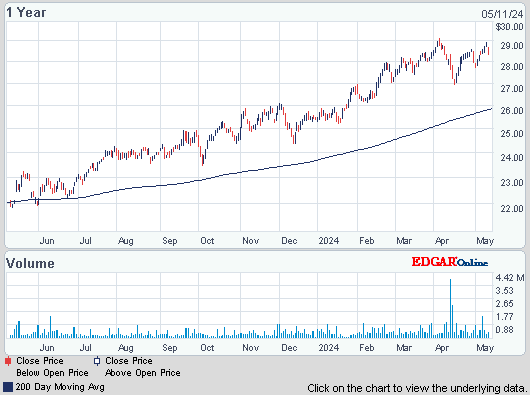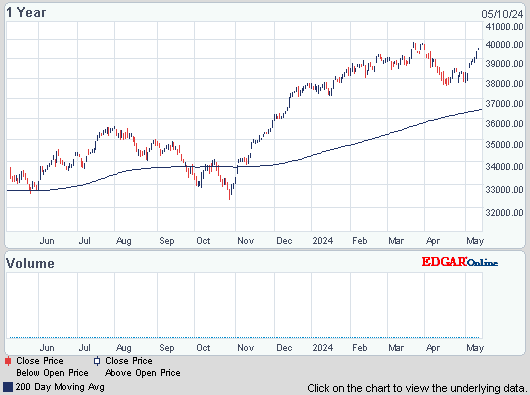Late day buying gave the Dow a gain of 42, but decliners were barely ahead of advancers & NAZ was up 2. The Financial Index was even at 201. The MLP index continued strong, up 1+ to 391, & the REIT index gained a fraction in the 262s. Junk bond funds were mixed to higher, remaining near yearly highs, while Treasuries rose after their recent decline.. Oil & gold moved little on this lackluster day of trading.

![Live 24 hours gold chart [Kitco Inc.]](http://www.kitco.com/images/live/gold.gif)

The federal budget deficit increased $70B in Jul & is on track to top $1T for the 4th straight year. The deficit for the first 10 months of the 2012 budget year (ending Sep 30) totaled $974B according to the Treasury. That's 11.5% less than the $1.1T gap in the same period last year. A slightly better economy has boosted income tax receipts, which have increased 6% so far this year. Corp income tax receipts rose nearly 30% compared to a year ago & spending has dipped 0.3%. The White House last month forecasted that the budget gap will total $1.2T this year, down from $1.3T in 2011. This year's gap is equal to about 7.8% of the US economy, down from 8.5% in 2011. The administration expects the deficit to fall just under $1T next year, to $991B. Swell!! DC gridlock could push the economy over the "fiscal cliff" at year's end when tax increases & deep spending cuts will take effect unless Congress reaches a budget agreement. Both parties oppose the automatic spending reductions because they include deep cuts in defense. If the tax increases & spending cuts take effect, a recession could follow. In addition, the debt ceiling will probably need to be raised prior to year end.
U.S. Budget Deficit Totals $974B Through July
Photo: Yahoo
Spanish Prime Minister Rajoy is fighting to prevent his country becoming the latest & biggest victim of the economic crisis crippling the 17 countries that use the € & ask for a full-blown gov bailout. But the clock is ticking for the country which is finding fewer & fewer buyers for its debt. Investors are charging the country increasingly higher rates so that it can borrow the money it needs. Investors have taken flight as the uncertainty over the whether the country can afford to contain the problems in its banking sector & indebted regional govs continues unabated. On the secondary market, the interest rate Spain would have to pay on 10-year debt has hovered around 7% for weeks which is unaffordable in the long-term. It's the pain threshold that eventually compelled Greece, Ireland & Portugal to request €B bailouts. High borrowing costs mean fewer funds for investment & gov austerity policies meant to save money to pay the increased interest rates could choke off growth. Last week, Spain sold €1.04B in 10-year bonds at an average interest rate of 6.65% & €1.02B in 4-year bonds at a rate of 5.97%, up from 5.54%. It has already managed to sell 72% of its targeted €86B in medium & long-term debt for this year. There are no good solutions for this debt mess.
How long can Spain take the financial heat? AP

Photo: Bloomberg
The UK economy may have shrunk less than previously estimated in Q2 after the statistics office reported a smaller slump in construction. Building output fell 3.9% according to the Office for Naitonal Statistics. That compares with a 5.2% drop in the first estimate of GDP 2 weeks ago, which showed the economy shrank 0.7%. The revision on its own would mean a 0.1 percentage point upward revision to GDP. The Bank of England cut its UK forecasts this week & said growth in the near term will be “subdued.” The central bank, which left its bond-purchase target unchanged at £375B ($585 B) this month, left the door open to more stimulus if needed, saying policy makers will do all they can to spur a recovery. The central bank said this week that “erratic factors” exaggerated the weakness in Q2 GDP, “Much of the contraction in the first half of this year reflects unusually large declines in measured construction output.” “Falls of that magnitude appear out of line with industry surveys and seem unlikely to persist.” This is a major euro economy & it is still shrinking.
British Contraction May Be Smaller as Construction Drop Revised: Economy
After the initial pop by the Dow at the opening on Mon, it has been pretty much trading sideways under 13.2K all week. There has not been significant news to drive the markets in either direction. But it remains under the surface. With a lack of attention on Europe, China has received more attention. It's trying to fix its economy, boost economic growth without aggravating inflation. The eurozone problems drag on, fixing a horrible debt mess while trying to emerge from recessions in many countries. The US economy appears better off than many others, but sluggish growth & looming tax increases at the start of the year keep demand for Treasuries strong. Next week, Dow will probably make another attempt to set a new 2012 high.

AMJ (Alerian MLP Index tracking fund)
Click below for the latest market update:
Treasury yields:
U.S. 3-month | 0.096% | |
U.S. 2-year | 0.261% | |
U.S. 10-year | 1.645% |
| CLU12.NYM | ...Crude Oil Sep 12 | ....92.42 | ... |
![Live 24 hours gold chart [Kitco Inc.]](http://www.kitco.com/images/live/gold.gif)

The federal budget deficit increased $70B in Jul & is on track to top $1T for the 4th straight year. The deficit for the first 10 months of the 2012 budget year (ending Sep 30) totaled $974B according to the Treasury. That's 11.5% less than the $1.1T gap in the same period last year. A slightly better economy has boosted income tax receipts, which have increased 6% so far this year. Corp income tax receipts rose nearly 30% compared to a year ago & spending has dipped 0.3%. The White House last month forecasted that the budget gap will total $1.2T this year, down from $1.3T in 2011. This year's gap is equal to about 7.8% of the US economy, down from 8.5% in 2011. The administration expects the deficit to fall just under $1T next year, to $991B. Swell!! DC gridlock could push the economy over the "fiscal cliff" at year's end when tax increases & deep spending cuts will take effect unless Congress reaches a budget agreement. Both parties oppose the automatic spending reductions because they include deep cuts in defense. If the tax increases & spending cuts take effect, a recession could follow. In addition, the debt ceiling will probably need to be raised prior to year end.
U.S. Budget Deficit Totals $974B Through July
Photo: Yahoo
Spanish Prime Minister Rajoy is fighting to prevent his country becoming the latest & biggest victim of the economic crisis crippling the 17 countries that use the € & ask for a full-blown gov bailout. But the clock is ticking for the country which is finding fewer & fewer buyers for its debt. Investors are charging the country increasingly higher rates so that it can borrow the money it needs. Investors have taken flight as the uncertainty over the whether the country can afford to contain the problems in its banking sector & indebted regional govs continues unabated. On the secondary market, the interest rate Spain would have to pay on 10-year debt has hovered around 7% for weeks which is unaffordable in the long-term. It's the pain threshold that eventually compelled Greece, Ireland & Portugal to request €B bailouts. High borrowing costs mean fewer funds for investment & gov austerity policies meant to save money to pay the increased interest rates could choke off growth. Last week, Spain sold €1.04B in 10-year bonds at an average interest rate of 6.65% & €1.02B in 4-year bonds at a rate of 5.97%, up from 5.54%. It has already managed to sell 72% of its targeted €86B in medium & long-term debt for this year. There are no good solutions for this debt mess.
How long can Spain take the financial heat? AP

Photo: Bloomberg
The UK economy may have shrunk less than previously estimated in Q2 after the statistics office reported a smaller slump in construction. Building output fell 3.9% according to the Office for Naitonal Statistics. That compares with a 5.2% drop in the first estimate of GDP 2 weeks ago, which showed the economy shrank 0.7%. The revision on its own would mean a 0.1 percentage point upward revision to GDP. The Bank of England cut its UK forecasts this week & said growth in the near term will be “subdued.” The central bank, which left its bond-purchase target unchanged at £375B ($585 B) this month, left the door open to more stimulus if needed, saying policy makers will do all they can to spur a recovery. The central bank said this week that “erratic factors” exaggerated the weakness in Q2 GDP, “Much of the contraction in the first half of this year reflects unusually large declines in measured construction output.” “Falls of that magnitude appear out of line with industry surveys and seem unlikely to persist.” This is a major euro economy & it is still shrinking.
British Contraction May Be Smaller as Construction Drop Revised: Economy
After the initial pop by the Dow at the opening on Mon, it has been pretty much trading sideways under 13.2K all week. There has not been significant news to drive the markets in either direction. But it remains under the surface. With a lack of attention on Europe, China has received more attention. It's trying to fix its economy, boost economic growth without aggravating inflation. The eurozone problems drag on, fixing a horrible debt mess while trying to emerge from recessions in many countries. The US economy appears better off than many others, but sluggish growth & looming tax increases at the start of the year keep demand for Treasuries strong. Next week, Dow will probably make another attempt to set a new 2012 high.
Dow Jones Industrials
Get your favorite symbols' Trend Analysis TODAY!



No comments:
Post a Comment